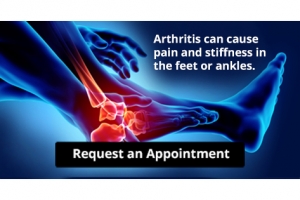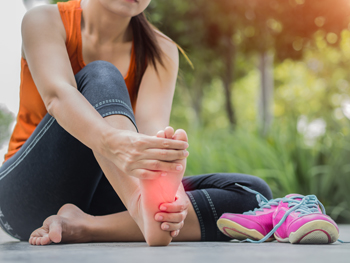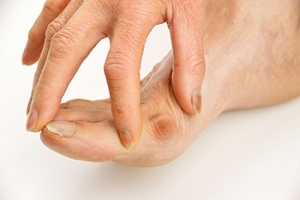Super User
Symptoms of Morton’s Neuroma
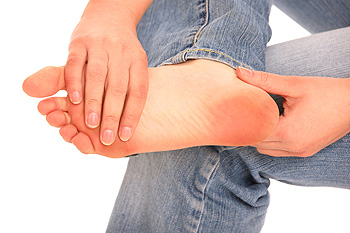 Many patients feel pain in the ball of their foot when the medical condition that is known as Morton’s neuroma exists. Additional symptoms can include a tingling or numbing sensation, and it may feel like there is a small stone or pebble in your shoe. It is an ailment that typically develops gradually and may occur from wearing shoes that do not fit correctly. There may also be medical conditions that can cause Morton’s neuroma. These can consist of having flat feet, bunions, hammertoes, or high arches. Mild relief may be found when wearing custom-made orthotics, shoes that are worn have adequate room in the toe area, or from getting foot massages that target the affected area. If you have symptoms of Morton’s neuroma, it is recommended that you speak with a podiatrist who can effectively treat this condition.
Many patients feel pain in the ball of their foot when the medical condition that is known as Morton’s neuroma exists. Additional symptoms can include a tingling or numbing sensation, and it may feel like there is a small stone or pebble in your shoe. It is an ailment that typically develops gradually and may occur from wearing shoes that do not fit correctly. There may also be medical conditions that can cause Morton’s neuroma. These can consist of having flat feet, bunions, hammertoes, or high arches. Mild relief may be found when wearing custom-made orthotics, shoes that are worn have adequate room in the toe area, or from getting foot massages that target the affected area. If you have symptoms of Morton’s neuroma, it is recommended that you speak with a podiatrist who can effectively treat this condition.
Morton’s neuroma is a very uncomfortable condition to live with. If you think you have Morton’s neuroma, contact Dr. Thomas E. Silver of Westwood Foot Clinic. Our doctor will attend to all of your foot care needs and answer any of your related questions.
Morton’s Neuroma
Morton's neuroma is a painful foot condition that commonly affects the areas between the second and third or third and fourth toe, although other areas of the foot are also susceptible. Morton’s neuroma is caused by an inflamed nerve in the foot that is being squeezed and aggravated by surrounding bones.
What Increases the Chances of Having Morton’s Neuroma?
- Ill-fitting high heels or shoes that add pressure to the toe or foot
- Jogging, running or any sport that involves constant impact to the foot
- Flat feet, bunions, and any other foot deformities
Morton’s neuroma is a very treatable condition. Orthotics and shoe inserts can often be used to alleviate the pain on the forefront of the feet. In more severe cases, corticosteroids can also be prescribed. In order to figure out the best treatment for your neuroma, it’s recommended to seek the care of a podiatrist who can diagnose your condition and provide different treatment options.
If you have any questions, please feel free to contact our office located in Golden Valley, MN . We offer the newest diagnostic and treatment technologies for all your foot care needs.
Read more about What is Morton's Neuroma?Why Does My Foot Hurt When I Get Out of Bed?
Does your day begin with a painful step when you get of bed? That stabbing pain in your heel may be plantar fasciitis. Plantar fasciitis is a condition that is brought about by inflammation of the plantar fascia, a ligament that runs along the bottom of the foot. Your first step of the day may have a painful feeling because your foot tries to heal itself overnight in a contracted position. When you take your first step of the day, the bottom of the foot is suddenly strained, causing pain in the heel and arch. Plantar fasciitis can have several different causes. In many cases, it is an injury stemming from overuse. Many athletes train too hard too quickly, leading to this type of injury. It can also be caused by poor foot biomechanics or wearing poorly fitted shoes. For more information about plantar fasciitis, consult with a podiatrist today.
Sports related foot and ankle injuries require proper treatment before players can go back to their regular routines. For more information, contact Dr. Thomas E. Silver of Westwood Foot Clinic. Our doctor can provide the care you need to keep you pain-free and on your feet.
Sports Related Foot and Ankle Injuries
Foot and ankle injuries are a common occurrence when it comes to athletes of any sport. While many athletes dismiss the initial aches and pains, the truth is that ignoring potential foot and ankle injuries can lead to serious problems. As athletes continue to place pressure and strain the area further, a mild injury can turn into something as serious as a rupture and may lead to a permanent disability. There are many factors that contribute to sports related foot and ankle injuries, which include failure to warm up properly, not providing support or wearing bad footwear. Common injuries and conditions athletes face, including:
- Plantar Fasciitis
- Plantar Fasciosis
- Achilles Tendinitis
- Achilles Tendon Rupture
- Ankle Sprains
Sports related injuries are commonly treated using the RICE method. This includes rest, applying ice to the injured area, compression and elevating the ankle. More serious sprains and injuries may require surgery, which could include arthroscopic and reconstructive surgery. Rehabilitation and therapy may also be required in order to get any recovering athlete to become fully functional again. Any unusual aches and pains an athlete sustains must be evaluated by a licensed, reputable medical professional.
If you have any questions please feel free to contact our office located in Golden Valley, MN . We offer the newest diagnostic and treatment technologies for all your foot and ankle needs.
Read more about Sports Related Foot And Ankle InjuriesPoor Circulation and the Lower Extremities
 There are a few telling signs that may indicate you are experiencing poor circulation in your lower legs and feet. Common symptoms of poor circulation may include fatigue or cramping during physical activity, cramping during inactivity, swelling and achiness, tingling, and a persistent coldness. Poor circulation can make going about your everyday activities incredibly uncomfortable and can be an indicator of more serious health concerns. A lack of feeling or numbness can also develop in your lower extremities, increasing the risk of wounds going undetected. If wounds develop on your feet and are left untreated, it’s possible they may become infected, which can lead to serious complications down the road. For professional advice on how to treat poor circulation in your lower legs and feet, please speak with a podiatrist.
There are a few telling signs that may indicate you are experiencing poor circulation in your lower legs and feet. Common symptoms of poor circulation may include fatigue or cramping during physical activity, cramping during inactivity, swelling and achiness, tingling, and a persistent coldness. Poor circulation can make going about your everyday activities incredibly uncomfortable and can be an indicator of more serious health concerns. A lack of feeling or numbness can also develop in your lower extremities, increasing the risk of wounds going undetected. If wounds develop on your feet and are left untreated, it’s possible they may become infected, which can lead to serious complications down the road. For professional advice on how to treat poor circulation in your lower legs and feet, please speak with a podiatrist.
While poor circulation itself isn’t a condition; it is a symptom of another underlying health condition you may have. If you have any concerns with poor circulation in your feet contact Dr. Thomas E. Silver of Westwood Foot Clinic. Our doctor will treat your foot and ankle needs.
Poor Circulation in the Feet
Peripheral artery disease (PAD) can potentially lead to poor circulation in the lower extremities. PAD is a condition that causes the blood vessels and arteries to narrow. In a linked condition called atherosclerosis, the arteries stiffen up due to a buildup of plaque in the arteries and blood vessels. These two conditions can cause a decrease in the amount of blood that flows to your extremities, therefore resulting in pain.
Symptoms
Some of the most common symptoms of poor circulation are:
- Numbness
- Tingling
- Throbbing or stinging pain in limbs
- Pain
- Muscle Cramps
Treatment for poor circulation often depends on the underlying condition that causes it. Methods for treatment may include insulin for diabetes, special exercise programs, surgery for varicose veins, or compression socks for swollen legs.
As always, see a podiatrist as he or she will assist in finding a regimen that suits you. A podiatrist can also prescribe you any needed medication.
If you have any questions, please feel free to contact our office located in Golden Valley, MN . We offer the newest diagnostic and treatment technologies for all your foot care needs.
Read more about Causes Symptoms and Treatment for Poor Circulation in the FeetTypes of Sesamoid Injuries
 The sesamoids are bones that are embedded in a tendon. They are found in several joints in the body. Within the feet, sesamoid bones are located in the ball of the foot, beneath the big toe joint. Injuries to the sesamoids can involve the bones, tendons, or surrounding tissues in the joint. There are three main types of sesamoid injuries. Turf toe is an injury of the soft tissue surrounding the big toe joint. A sesamoid fracture is a break in the sesamoid bone, and can be acute or chronic. Sesamoiditis is an overuse injury caused by chronic inflammation of the sesamoid bones and the surrounding tendons. If you have a sesamoid injury, it is recommended that you seek the care of a podiatrist who can properly treat your condition.
The sesamoids are bones that are embedded in a tendon. They are found in several joints in the body. Within the feet, sesamoid bones are located in the ball of the foot, beneath the big toe joint. Injuries to the sesamoids can involve the bones, tendons, or surrounding tissues in the joint. There are three main types of sesamoid injuries. Turf toe is an injury of the soft tissue surrounding the big toe joint. A sesamoid fracture is a break in the sesamoid bone, and can be acute or chronic. Sesamoiditis is an overuse injury caused by chronic inflammation of the sesamoid bones and the surrounding tendons. If you have a sesamoid injury, it is recommended that you seek the care of a podiatrist who can properly treat your condition.
Foot Pain
Foot pain can be extremely painful and debilitating. If you have a foot pain, consult with Dr. Thomas E. Silver from Westwood Foot Clinic. Our doctor will assess your condition and provide you with quality foot and ankle treatment.
Causes
Foot pain is a very broad condition that could be caused by one or more ailments. The most common include:
- Bunions
- Hammertoes
- Plantar Fasciitis
- Bone Spurs
- Corns
- Tarsal Tunnel Syndrome
- Ingrown Toenails
- Arthritis (such as Gout, Rheumatoid, and Osteoarthritis)
- Flat Feet
- Injury (from stress fractures, broken toe, foot, ankle, Achilles tendon ruptures, and sprains)
- And more
Diagnosis
To figure out the cause of foot pain, podiatrists utilize several different methods. This can range from simple visual inspections and sensation tests to X-rays and MRI scans. Prior medical history, family medical history, and any recent physical traumatic events will all be taken into consideration for a proper diagnosis.
Treatment
Treatment depends upon the cause of the foot pain. Whether it is resting, staying off the foot, or having surgery; podiatrists have a number of treatment options available for foot pain.
If you have any questions, please feel free to contact our office located in Golden Valley, MN . We offer the newest diagnostic and treatment technologies for all your foot care needs.
Read more about Foot PainPreventing Falls in the Home
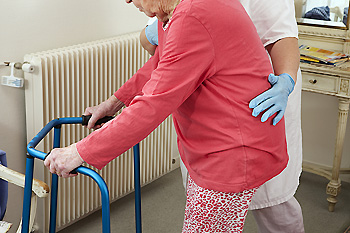 Falling can be dangerous for the elderly, and while you should be vigilant while outdoors, most falls actually occur inside the home. Making the home a safe environment by finding and fixing tripping and falling hazards, can help prevent falls. Some potential tripping hazards are computer and electrical wires, which can be made less dangerous by coiling them next to walls and taping them down when possible. Staying physically active and managing your medications can improve overall health and also make falls less likely. Another step that you can implement is taking care of your feet by wearing the proper footwear and regularly visiting a podiatrist. For more information about foot health and falls prevention, talk to a podiatrist today.
Falling can be dangerous for the elderly, and while you should be vigilant while outdoors, most falls actually occur inside the home. Making the home a safe environment by finding and fixing tripping and falling hazards, can help prevent falls. Some potential tripping hazards are computer and electrical wires, which can be made less dangerous by coiling them next to walls and taping them down when possible. Staying physically active and managing your medications can improve overall health and also make falls less likely. Another step that you can implement is taking care of your feet by wearing the proper footwear and regularly visiting a podiatrist. For more information about foot health and falls prevention, talk to a podiatrist today.
Preventing falls among the elderly is very important. If you are older and have fallen or fear that you are prone to falling, consult with Dr. Thomas E. Silver from Westwood Foot Clinic. Our doctor will assess your condition and provide you with quality advice and care.
Every 11 seconds, an elderly American is being treated in an emergency room for a fall related injury. Falls are the leading cause of head and hip injuries for those 65 and older. Due to decreases in strength, balance, senses, and lack of awareness, elderly persons are very susceptible to falling. Thankfully, there are a number of things older persons can do to prevent falls.
How to Prevent Falls
Some effective methods that older persons can do to prevent falls include:
- Enrolling in strength and balance exercise program to increase balance and strength
- Periodically having your sight and hearing checked
- Discuss any medications you have with a doctor to see if it increases the risk of falling
- Clearing the house of falling hazards and installing devices like grab bars and railings
- Utilizing a walker or cane
- Wearing shoes that provide good support and cushioning
- Talking to family members about falling and increasing awareness
Falling can be a traumatic and embarrassing experience for elderly persons; this can make them less willing to leave the house, and less willing to talk to someone about their fears of falling. Doing such things, however, will increase the likelihood of tripping or losing one’s balance. Knowing the causes of falling and how to prevent them is the best way to mitigate the risk of serious injury.
If you have any questions, please feel free to contact our office located in Golden Valley, MN . We offer the newest diagnostic and treatment technologies for all your foot care needs.
Read more about Falls PreventionCommon Reasons for Ankle Pain
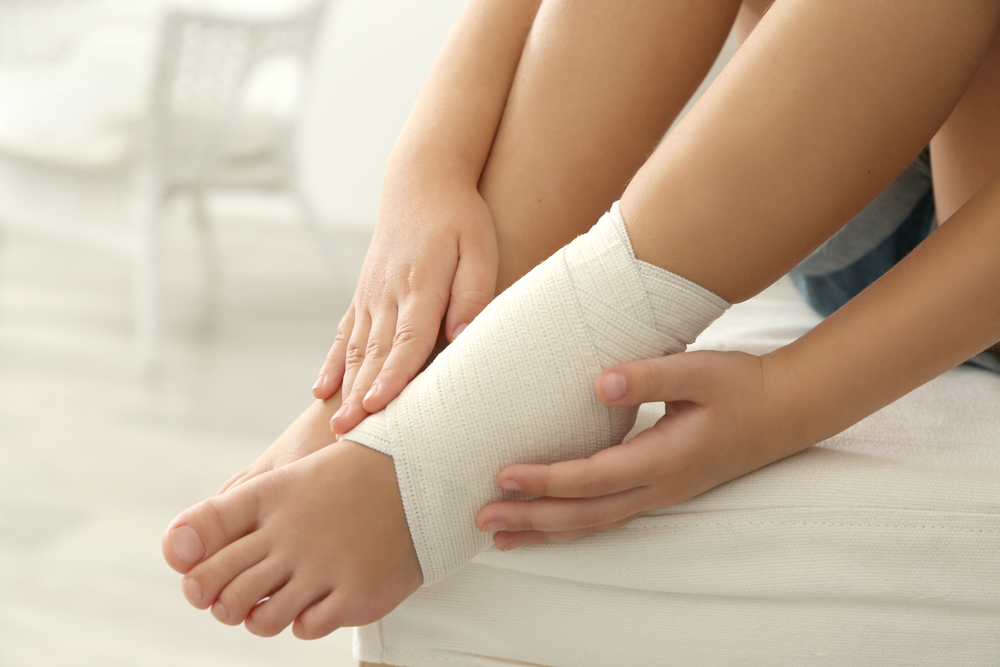 Your ankle can hurt for a variety of reasons. The most common cause of ankle pain is an injury, such as a strain or a sprain. A strain is an injury to the muscle or tendon of the ankle, while a sprain is an injury to the ligament. Both types of injuries can vary in severity and may cause pain or discomfort, tenderness, and swelling. Other possible injuries of the ankle include Achilles tendon ruptures or ankle fractures, which are more severe in nature. Several types of arthritis can affect the ankle, including osteoarthritis, rheumatoid arthritis, and gout. An infection, in which bacteria enters the skin or the joint around the ankle can cause pain and swelling, in addition to fever and fatigue. Flat feet or fallen arches may lead to ankle pain as well. If you are experiencing ankle pain, it is recommended that you see a podiatrist for a proper diagnosis and to begin the best course of treatment that is right for you.
Your ankle can hurt for a variety of reasons. The most common cause of ankle pain is an injury, such as a strain or a sprain. A strain is an injury to the muscle or tendon of the ankle, while a sprain is an injury to the ligament. Both types of injuries can vary in severity and may cause pain or discomfort, tenderness, and swelling. Other possible injuries of the ankle include Achilles tendon ruptures or ankle fractures, which are more severe in nature. Several types of arthritis can affect the ankle, including osteoarthritis, rheumatoid arthritis, and gout. An infection, in which bacteria enters the skin or the joint around the ankle can cause pain and swelling, in addition to fever and fatigue. Flat feet or fallen arches may lead to ankle pain as well. If you are experiencing ankle pain, it is recommended that you see a podiatrist for a proper diagnosis and to begin the best course of treatment that is right for you.
Ankle pain can be caused by a number of problems and may be potentially serious. If you have ankle pain, consult with Dr. Thomas E. Silver from Westwood Foot Clinic. Our doctor will assess your condition and provide you with quality foot and ankle treatment.
Ankle pain is any condition that causes pain in the ankle. Due to the fact that the ankle consists of tendons, muscles, bones, and ligaments, ankle pain can come from a number of different conditions.
Causes
The most common causes of ankle pain include:
- Types of arthritis (rheumatoid, osteoarthritis, and gout)
- Ankle sprains
- Broken ankles
- Achilles tendinitis
- Achilles tendon rupture
- Stress fractures
- Bursitis
- Tarsal tunnel syndrome
- Plantar fasciitis
Symptoms
Symptoms of ankle injury vary based upon the condition. Pain may include general pain and discomfort, swelling, aching, redness, bruising, burning or stabbing sensations, and/or loss of sensation.
Diagnosis
Due to the wide variety of potential causes of ankle pain, podiatrists will utilize a number of different methods to properly diagnose ankle pain. This can include asking for personal and family medical histories and of any recent injuries. Further diagnosis may include sensation tests, a physical examination, and potentially x-rays or other imaging tests.
Treatment
Just as the range of causes varies widely, so do treatments. Some more common treatments are rest, ice packs, keeping pressure off the foot, orthotics and braces, medication for inflammation and pain, and surgery.
If you have any questions, please feel free to contact our office located in Golden Valley, MN . We offer the newest diagnostic and treatment technologies for all your foot care needs.
Read more about Ankle Pain
What Caused My Cracked Heels?
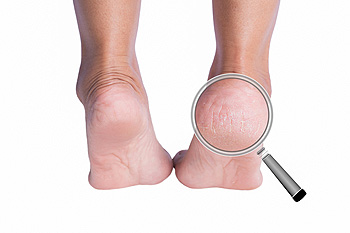 Dry, cracked heels can have a variety of different causes. Standing for prolonged periods of time, especially on a hard floor, wearing thin-soled shoes, or obesity, can increase pressure on the heel, causing cracks to appear. Conditions such as eczema, atopic dermatitis, psoriasis, palmoplantar keratoderma, and juvenile plantar dermatosis affect the skin of the feet and could increase the risk of developing cracked heels. Certain systemic conditions, like diabetes or neuropathy, can make one more likely to develop cracks and may make it more difficult to feel those cracks due to a loss in sensation in the feet. Another common cause of dry, cracked heels is footwear without a proper back, such as open sandals and flip-flops, because they expose your heels to the elements and don’t provide adequate support. If you have dry, cracked heels that are causing you pain or discomfort, please seek the care of a podiatrist.
Dry, cracked heels can have a variety of different causes. Standing for prolonged periods of time, especially on a hard floor, wearing thin-soled shoes, or obesity, can increase pressure on the heel, causing cracks to appear. Conditions such as eczema, atopic dermatitis, psoriasis, palmoplantar keratoderma, and juvenile plantar dermatosis affect the skin of the feet and could increase the risk of developing cracked heels. Certain systemic conditions, like diabetes or neuropathy, can make one more likely to develop cracks and may make it more difficult to feel those cracks due to a loss in sensation in the feet. Another common cause of dry, cracked heels is footwear without a proper back, such as open sandals and flip-flops, because they expose your heels to the elements and don’t provide adequate support. If you have dry, cracked heels that are causing you pain or discomfort, please seek the care of a podiatrist.
Cracked heels are unsightly and can cause further damage to your shoes and feet. If you have any concerns, contact Dr. Thomas E. Silver from Westwood Foot Clinic. Our doctor can provide the care you need to keep you pain-free and on your feet.
Cracked Heels
Cracked heels appear unappealing and can make it harder for you walk around in sandals. Aside from looking unpleasant, cracked heels can also tear stockings, socks, and wear out your shoes. There are several methods to help restore a cracked heel and prevent further damage.
How Do You Get Them?
Dry skin is the number one culprit in creating cracked heels. Many athletes, walkers, joggers, and even swimmers suffer from cracked heels. Age and skin oil production play a role to getting cracked heels as well.
Promote Healing
Over the counter medicines can help, especially for those that need instant relief or who suffer from chronic dry feet.
Wear Socks – Wearing socks with medicated creams helps lock in moisture.
Moisturizers – Applying both day and night will help alleviate dryness which causes cracking.
Pumice Stones – These exfoliate and remove dead skin, which allows for smoother moisturizer application and better absorption into the skin.
Change in Diet
Eating healthy with a well-balanced diet will give the skin a fresh and radiant look. Your body responds to the kinds of food you ingest. Omega-3 fatty acids and zinc supplements can also revitalize skin tissue.
Most importantly, seek professional help if unsure how to proceed in treating cracked heels. A podiatrist will help you with any questions or information needed.
If you have any questions, please feel free to contact our office located in Golden Valley, MN . We offer the newest diagnostic and treatment technologies for all your foot care needs.
Read more about Solutions for Cracked HeelsWhen Should I Get New Orthotics?
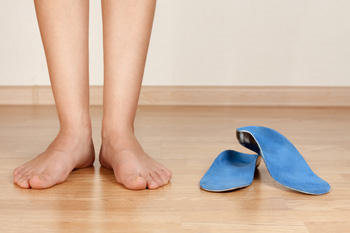 Custom orthotics are frequently prescribed to treat various foot conditions, such as plantar fasciitis, arthritis, and gait abnormalities. Once you begin wearing custom orthotics, you may find being on your feet a lot more pleasant. Unfortunately, orthotics can and do wear out over time. If you find that your feet have begun to hurt again after wearing your orthotics for a while, then it may be time to replace them. It is also recommended that you inspect your orthotics for wear and tear. If you see cracks, broken pieces, or thinned soles, the orthotics are likely past their best. It is also recommended to check the bottom of your shoes for signs of uneven wear. Orthotics are meant to correct any deformities in your feet and your shoes can tell you if there are any signs of uneven wear. If you are experiencing any type of foot pain and think that you may benefit from orthotics, or if you wear orthotics and think that you might need a new pair, it is suggested that you consult with a podiatrist.
Custom orthotics are frequently prescribed to treat various foot conditions, such as plantar fasciitis, arthritis, and gait abnormalities. Once you begin wearing custom orthotics, you may find being on your feet a lot more pleasant. Unfortunately, orthotics can and do wear out over time. If you find that your feet have begun to hurt again after wearing your orthotics for a while, then it may be time to replace them. It is also recommended that you inspect your orthotics for wear and tear. If you see cracks, broken pieces, or thinned soles, the orthotics are likely past their best. It is also recommended to check the bottom of your shoes for signs of uneven wear. Orthotics are meant to correct any deformities in your feet and your shoes can tell you if there are any signs of uneven wear. If you are experiencing any type of foot pain and think that you may benefit from orthotics, or if you wear orthotics and think that you might need a new pair, it is suggested that you consult with a podiatrist.
If you are having discomfort in your feet and would like to try orthotics, contact Dr. Thomas E. Silver from Westwood Foot Clinic. Our doctor can provide the care you need to keep you pain-free and on your feet.
What Are Orthotics?
Orthotics are inserts you can place into your shoes to help with a variety of foot problems such as flat feet or foot pain. Orthotics provide relief and comfort for minor foot and heel pain but can’t correct serious biomechanical problems in your feet.
Over-the-Counter Inserts
Orthotics come in a wide variety of over-the-counter inserts that are used to treat foot pain, heel pain, and minor problems. For example, arch supports can be inserted into your shoes to help correct overarched or flat feet, while gel insoles are often used because they provide comfort and relief from foot and heel pain by alleviating pressure.
Prescription Orthotics
If over-the-counter inserts don’t work for you or if you have a more severe foot concern, it is possible to have your podiatrist prescribe custom orthotics. These high-quality inserts are designed to treat problems such as abnormal motion, plantar fasciitis, and severe forms of heel pain. They can even be used to help patients suffering from diabetes by treating foot ulcers and painful calluses and are usually molded to your feet individually, which allows them to provide full support and comfort.
If you are experiencing minor to severe foot or heel pain, it’s recommended to speak with your podiatrist about the possibilities of using orthotics. A podiatrist can determine which type of orthotic is right for you and allow you to take the first steps towards being pain-free.
If you have any questions please contact our office located in Golden Valley, MN . We offer the newest diagnostic and treatment technologies for all your foot and ankle needs.
Read more about Ankle Foot Orthotics for AthletesStrengthen Your Feet by Practicing Yoga
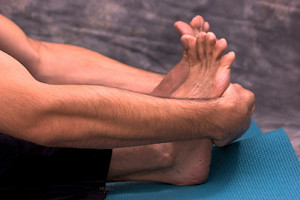 To help keep your feet strong and flexible, it can be beneficial to practice certain yoga stretches. One stretch you can practice is performed by standing on your feet, and slowly lifting yourself up on your toes. Slowly lower yourself to your beginning position, then rock forward and backward on the heels. Another yoga stretch you can practice involves standing on a step with your heels slightly hanging off. Begin lifting your heels up and down, repeating this action. These stretches can help prevent injury by strengthening your feet and increasing their flexibility. For more advice on what yoga stretches are beneficial for the feet, please consult with a podiatrist.
To help keep your feet strong and flexible, it can be beneficial to practice certain yoga stretches. One stretch you can practice is performed by standing on your feet, and slowly lifting yourself up on your toes. Slowly lower yourself to your beginning position, then rock forward and backward on the heels. Another yoga stretch you can practice involves standing on a step with your heels slightly hanging off. Begin lifting your heels up and down, repeating this action. These stretches can help prevent injury by strengthening your feet and increasing their flexibility. For more advice on what yoga stretches are beneficial for the feet, please consult with a podiatrist.
Stretching the feet is a great way to prevent injuries. If you have any concerns with your feet consult with Dr. Thomas E. Silver from Westwood Foot Clinic. Our doctor will assess your condition and provide you with quality foot and ankle treatment.
Stretching the Feet
Being the backbone of the body, the feet carry your entire weight and can easily become overexerted, causing cramps and pain. As with any body part, stretching your feet can serve many benefits. From increasing flexibility to even providing some pain relief, be sure to give your feet a stretch from time to time. This is especially important for athletes or anyone performing aerobic exercises, but anyone experiencing foot pain or is on their feet constantly should also engage in this practice.
Great ways to stretch your feet:
- Crossing one leg over the others and carefully pull your toes back. Do 10-20 repetitions and repeat the process for each foot
- Face a wall with your arms out and hands flat against the wall. Step back with one foot and keep it flat on the floor while moving the other leg forward. Lean towards the wall until you feel a stretch. Hold for 30 seconds and perform 10 repetitions for each foot
- Be sure not to overextend or push your limbs too hard or you could risk pulling or straining your muscle
Individuals who tend to their feet by regular stretching every day should be able to minimize foot pain and prevent new problems from arising.
If you have any questions, please feel free to contact our office located in Golden Valley, MN . We offer the newest diagnostic and treatment technologies for all your foot care needs.
Read more about Stretching Your FeetDo I Have a Bunion?
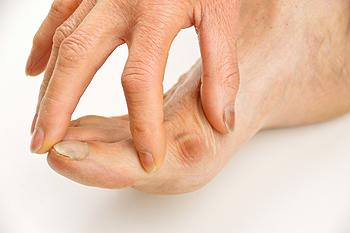 Bunions are bony lumps that are on the side of the foot next to the big toe. Some common symptoms include the big toe pointing towards the other toes or hardened and red skin over the bump. Bunions may also cause pain on the bottom or side of the foot when walking or wearing shoes. If you are experiencing pain from a bunion, some tips include wearing wide shoes with a soft sole, using bunion pads, or losing weight. If the pain is getting worse, or you have diabetes, it is important to consult with a podiatrist. A podiatrist can provide options for pain relief, and bunions can only be removed via surgery from a podiatric surgeon.
Bunions are bony lumps that are on the side of the foot next to the big toe. Some common symptoms include the big toe pointing towards the other toes or hardened and red skin over the bump. Bunions may also cause pain on the bottom or side of the foot when walking or wearing shoes. If you are experiencing pain from a bunion, some tips include wearing wide shoes with a soft sole, using bunion pads, or losing weight. If the pain is getting worse, or you have diabetes, it is important to consult with a podiatrist. A podiatrist can provide options for pain relief, and bunions can only be removed via surgery from a podiatric surgeon.
If you are suffering from bunions, contact Dr. Thomas E. Silver of Westwood Foot Clinic. Our doctor can provide the care you need to keep you pain-free and on your feet.
What Is a Bunion?
A bunion is formed of swollen tissue or an enlargement of boney growth, usually located at the base joint of the toe that connects to the foot. The swelling occurs due to the bones in the big toe shifting inward, which impacts the other toes of the foot. This causes the area around the base of the big toe to become inflamed and painful.
Why Do Bunions Form?
Genetics – Susceptibility to bunions are often hereditary
Stress on the feet – Poorly fitted and uncomfortable footwear that places stress on feet, such as heels, can worsen existing bunions
How Are Bunions Diagnosed?
Doctors often perform two tests – blood tests and x-rays – when trying to diagnose bunions, especially in the early stages of development. Blood tests help determine if the foot pain is being caused by something else, such as arthritis, while x-rays provide a clear picture of your bone structure to your doctor.
How Are Bunions Treated?
- Refrain from wearing heels or similar shoes that cause discomfort
- Select wider shoes that can provide more comfort and reduce pain
- Anti-inflammatory and pain management drugs
- Orthotics or foot inserts
- Surgery
If you have any questions, please feel free to contact our office located in Golden Valley, MN . We offer the newest diagnostic and treatment technologies for all your foot care needs.
Read more about What Are Bunions?
